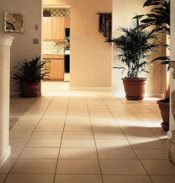
Ceramic Tile, glazed
How to:
Seal | Clean | Repair | Protect
Strip & Restore | Easy Care


Usually does not need to be sealed. But, the grout does need to be sealed.
More Considerations for glazed finishes, including metallic:
Usually no protection of the face is needed during installation. The grout residue cleans up completely with water and a sponge. It is standard practice in the industry to clean off any remaining hazy residue by one of the following methods:Buffing with cloth Cleaning with vinegar. This is a very weak acid and works fine, except for its tendency to leave an opalescent film. Using a grout residue removing product. If there is concern for grout residue problems due to tile texture (or finish as with matte type glazes), then keep grout residue out of any surface texture characteristics by coating with a non-sealer "grout release" before grouting. This should be a water soluble coating that comes off easily while grout is being cleaned up with water and a sponge.
Efflorescence (subsurface originating white powdery stains) can occur in the grout. However, it is easily cleaned. Grout colors can "fade". The appearance of fading is actually from light efflorescence and can be stopped by sealing with the appropriate sealer. Some glazes could scratch during installation, however, one of the "solvent-penetrating" sealers tends to make the scratches disappear on some finishes. Test a sample first. Metallic glazes: These can look like solid metal all the way through, but in reality are a kiln fired coating on a clay body. Many of these are absorbent and therefore can be stained. Test absorbency with water drops and consider testing a petroleum penetrating acrylic sealer as a way to protect the finish and also enhance the metallic coloring.
- The products you may need for surface Preparation before sealing.
- Pictures of each of the recommended sealers for this surface type. Click the sealer's picture for it's full description.
- Handy tips to prevent issues that others have had before coming to Aldon.
- Perhaps more information than you need now, but might be of interest later.
Your Choices for Sealing
This surface usually does not require sealing, but the grout does. A water base penetrating sealer will be easier because the excess wipes off the tile face if done soon.
Our suggestions to test are:- Water based penetrating that is usually invisible when dry.
- Click here to see What effects you can expect from each sealer type.
- Click here to see our suggested sealers, cleaners, and application tools.
Some questions you may not be thinking to ask right now that could become important:
. Was it sealed in the past? Does that matter?
. Will a new sealer be compatible with whatever was used before?
. What sealer will give the visual results you want?
. Will you also be able to have a sealer solve problem(s)? ( Answer: yes. Just know which to pick.)
Items of Interest
How to select a sealer
A sealer can do far more than just bead water and look pretty! To see what that is click here.
Important: If your project has had any sealer applied in the past, it must be evaluated differently. To see why, Click here!
Sealer "solids" levels?
A porous surface will require more gallons (more money) of a lower solids sealer than using a higher solids level sealer. That, plus different surfaces have different requirements. It is only a matter of which is best for your needs.
The more porous the surface, the more solids will be required to achieve the desired effects of gloss, strengthening, stopping efflorescence, etc.
The more porous the surface, generally the greater the need for the sealer to create a stronger surface.
An old sealer below the surface, even after stripping, will lower the absorption and porosity to some degree. Sometimes it is uneven below the surface and can create an uneven coloring effect with a color enhancing sealer applied later. Another reason to test first.
Do not believe yet that you have the type of surfacing you were told:
Colors fading?
Renew a glossy finish
Re: "penetrating sealers": do not apply thin layer upon thin layer. Apply a sufficient quantity to insure below surface penetration & bonding. A layer of sealer on top of another layer of sealer can result in poor bonding between layers and that can cause separation peeling that looks grayish.
Concerned about Doing It Yourself or what your contractor says?
If you are concerned about doing it yourself - consider that the satisfaction of a project is directly related to YOUR knowledge of what needs to be done and how. Who actually does the work is less important.
The goal for contractors is - NO CALL BACKS. A good contractor will understand the logic of not taking shortcuts.
©
The goal for contractors is - NO CALL BACKS. A good contractor will understand the logic of not taking shortcuts.
